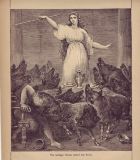Maybe you spent a quiet day of reflection, or maybe you choked down greasy food while your uncle ranted in his MAGA hat. Even when our living and known ancestors aren't people we easily love, ancestors are the best source of spiritual connection.
An ancestor altar can be large or small, in an out-of-the-way corner or in a prominent spot. Someone with roommates or privacy concerns could have something as simple as a picture of a departed loved one with a candle.
There are no rules, except not to mingle things of the living on the ancestor altar, less the ones who have passed on call to the living and bring them over too soon.
My altar recently grew, partly with the addition of some great art. Spending money and having artwork isn't needed--an altar can be simpler or even feature your own artwork. Besides the work I bought from an artist--and supporting artists and rootworkers is important to me--most items on the altar are things I already had.

An ancestor altar can be large or small, in an out-of-the-way corner or in a prominent spot. Someone with roommates or privacy concerns could have something as simple as a picture of a departed loved one with a candle.
There are no rules, except not to mingle things of the living on the ancestor altar, less the ones who have passed on call to the living and bring them over too soon.
My altar recently grew, partly with the addition of some great art. Spending money and having artwork isn't needed--an altar can be simpler or even feature your own artwork. Besides the work I bought from an artist--and supporting artists and rootworkers is important to me--most items on the altar are things I already had.
This lovely shoe artwork is the center of my altar. It represents justice and diversity, and was made by the wonderful Auntie Sindy at Todomojo, who offers lots of reliquaries, artwork, and readings. The mirror with shells around it was made by my Grandpa and is positioned to help show off the back of the shoe. All animal products were humanely gathered from naturally-deceased animals.
The back of the shoe has vertebrae (again, humanely collected). It reminds me of my need to work on my root chakra and remain mindful of the needs of my spine, a particular challenge through my life. The scarf belonged to my grandma.
Both sides of the shoe are gorgeous. My deceased protector/familiar dog watches over from behind.
The front of the shoe pushes forward, the dollies representing diversity. My husband's family is more highlighted on one side of the altar (mine on the other--but they are not strictly segregated), and we use battery-operated candles for a 24-hour burning without fire worries when we are gone or asleep.

Our altar is the top of an entertainment center. The dolly to the right is made of my Grandma's old scarves. The tin cup belonged to my grandparents and sat by their sink; I use it for liquid offerings. We honor human family, but also our deceased animal companions and musicians (such as the print of John Lennon's Little Flower Princess lyrics).






